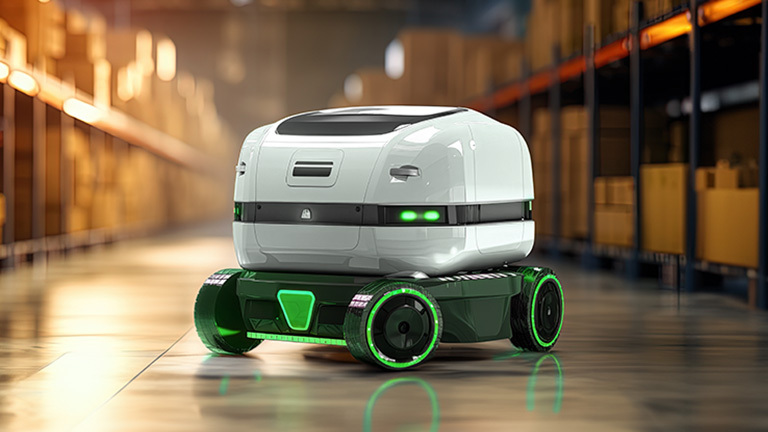This blog post was originally published at Avnet’s website. It is reprinted here with the permission of Avnet.
Autonomous mobile robots (AMRs) are revolutionizing industries such as manufacturing, logistics, agriculture, and healthcare by performing tasks that are too dangerous, tedious, or costly for humans. AMRs can navigate complex and dynamic environments, communicate with other devices and systems, and make intelligent decisions based on sensor data and machine learning.
At the heart of these capabilities lie sophisticated electronic components. High-performance processors, such as microcontrollers and microprocessors, provide the computational power necessary for real-time decision-making and navigation. Advanced sensors and image processing, enable perception and environmental awareness, allowing AMRs to detect obstacles, navigate paths, and interact safely with their surroundings. High-performance memory ensures that critical data is collected and stored quickly and securely.
Additionally, antennas for wireless communication, such as Wi-Fi, Bluetooth, and cellular connectivity, facilitate seamless interaction with other devices, systems, and the cloud, enabling remote monitoring, control, and fleet management.
However, designing AMRs is not an easy feat, as it involves many technical and business challenges that require a holistic and integrated approach. In this article, we will discuss some of the key challenges of designing AMRs and how Avnet, a leading global technology solutions provider, can help you overcome them with its end-to-end ecosystem of products and services.
Connectivity/Interoperability
One of the main challenges of designing AMRs is ensuring that they can connect and interoperate with other devices and systems, such as smart home appliances, electric vehicles, cloud platforms, and industrial networks. This requires adopting common standards and protocols, ensuring compatibility and compliance, and managing security and privacy risks. Autonomous mobile robots use wireless communication technologies such as Wi-Fi, Bluetooth, LoRa, Zigbee, and cellular networks to communicate with each other and with other devices. These technologies enable robots to share data, coordinate their activities, and respond to changing conditions. Avnet brings the hardware components such as antennas, connectors, sensors, memory and of course processors that provide the connectivity you need. Avnet can also help you with testing and certification services and cloud and edge computing platforms, to ensure that your AMRs can seamlessly integrate with different ecosystems and applications.
Sensor networks
Autonomous mobile robots rely heavily on sensor networks to collect data about their environment and share it with other robots and devices.
The uses include localization and mapping because AMRs need to know their precise position within their environment while Simultaneous Localization and Mapping (SLAM) algorithms use sensor data to create maps of the robot’s surroundings.
This includes obstacle detection and avoidance with vision, light and sound-based sensors that analyze images to recognize obstacles, lane markings and other relevant features to ensure proper direction and safety. As well as environmental sensing for temperature and chemical sensing along with motion and speed monitoring and control.
Power Density
Space is often limited in robotic applications, but careful component selection, design and layout can make all the difference. Efficient power conversion, storage and delivery help ensure that higher power requirements can be met while reducing the overall size of the product.
Whether it includes wireless charging, efficient motor control, or higher power interconnect solutions, power density must be an early consideration of the overall design.
Reduced Cost
Cost reduction can take on different forms that include the overall system cost, or the cost of ownership.
Cost of ownership affects the designs of AMRs from not only the initial purchase price but also the ongoing costs such as maintenance, repairs, upgrades and energy consumption. Designers need to strike a balance between incorporating advanced features and maintaining affordability.
Overall system cost is much the same because each component and layout decision can affect the system cost.
In the early design phase engineers must make trade-offs between cost and performance. For example, using high-end sensors and processors can enhance the capabilities, but will also drive up the cost. This means finding cost-effective components and utilizing efficient design processes will lead to a lower cost of ownership as well as lower system costs.
Conclusion
Autonomous Mobile Robots are playing an ever-growing part in our daily lives whether it’s inventory transportation, sorting or loading in a factory/warehouse setting, cleaning and sanitation for medical applications as well as package delivery and agriculture equipment. As these robots advance with more features and capabilities, they require higher power, faster processing, more accurate sensors and deeper data storage. Designing for these trends can be a challenge, Avnet is uniquely positioned to meet that challenge head-on with a deep line card of industry-leading suppliers and design support from factory-trained engineers and a deep library of reference designs.
Jamie Pederson
Technical Content Manager, Avnet
On June 11 and 13, 2024, Alliance Member company Avnet, along with partner technology suppliers such as fellow Alliance Members Advantech, Microchip Technology, Micron Technology and Renesas, will deliver the webinar series “The Future of Mobile Autonomous Robots“. For more information and to register for one, multiple or all of the webinars, visit the main event page.



